Are all the colours of the rainbow reflected in the flowers in the garden? I expected that green flowers would be the hardest to find, but I was wrong.

The seven colours of the rainbow: red, orange, yellow, green, blue, indigo, violet through to red again (Graphic from: commons.wikimedia.org/wiki/File:Rainbow-Regenbogen-meshgradient.png)
I can remember in school science classes being entranced to see white light refracted through a glass prism and dispersed into the seven colours of the rainbow.
These seven colours were named by the English scientist Isaac Newton (1643–1727) after he used a prism to disperse white light into colours. Newton distinguished seven colours in the spectrum to match the seven musical notes in the scale, in line with the belief dating back to the Ancient Greek Sophists that there was a connection between colours, musical notes, the days of the week, and the seven then known objects in the solar system in addition to Earth, these being the sun, the moon, and five planets (Mercury, Venus, Mars, Saturn and Jupiter)
In the 1800s scientific work led to the first discovery that the visible spectrum is only part of a much larger spectrum of electromagnetic waves. Within the visible spectrum, the colour red has the longest wavelength, but the shortest frequency and the lowest energy. Violet light is at the other end of the scale, and has the shortest wavelength and the highest frequency and energy.

A red Freesia laxa in the mini-grassland in our garden
The visible spectrum that humans can see usually spans from red to violet and includes all the colours in between. However, some people can see further into infrared at the one end of the spectrum and others into the ultraviolet part of the spectrum. Generally, humans see further into the red spectrum than most other animals.
Pollinators, such as honey bees, can see ultraviolet but not red. Many flowers, but not all, have ultraviolet markings that guide pollinators to the nectar and pollen. Although bees cannot see the colour red, they can detect red flowers if they contrast clearly with the surrounding foliage, but they take longer to find red flowers compared to finding flowers in the bluer part of the spectrum.
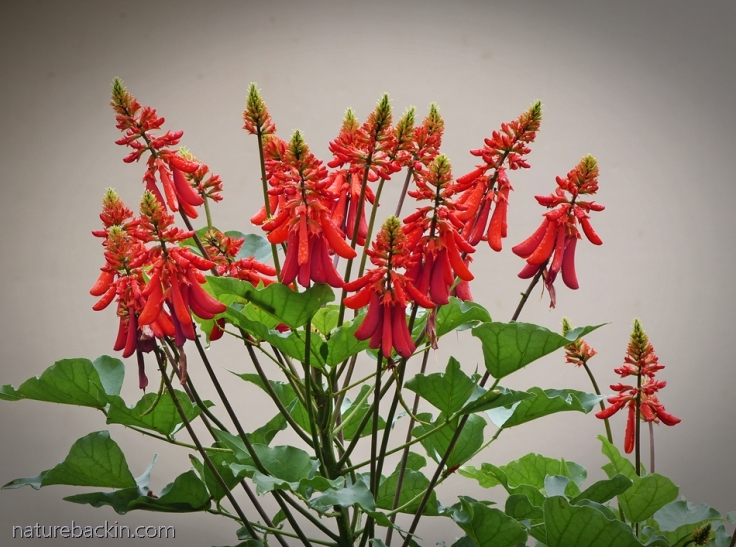
The red flowers of this Dwarf Coral-Tree (Erythrina humeana) are favoured by sunbirds seeking their nectar
Many ‘bird flowers’, which have more nectar for their avian visitors than predominantly insect-pollinated flowers, are red in colour. However, insects still visit these flowers although perhaps more in search of their pollen than the nectar. And even though birds are attracted to red flowers, they can see the entire visible spectrum right through to ultraviolet. So birds as well as insects make use of the ultraviolet markings on suitable flowers.
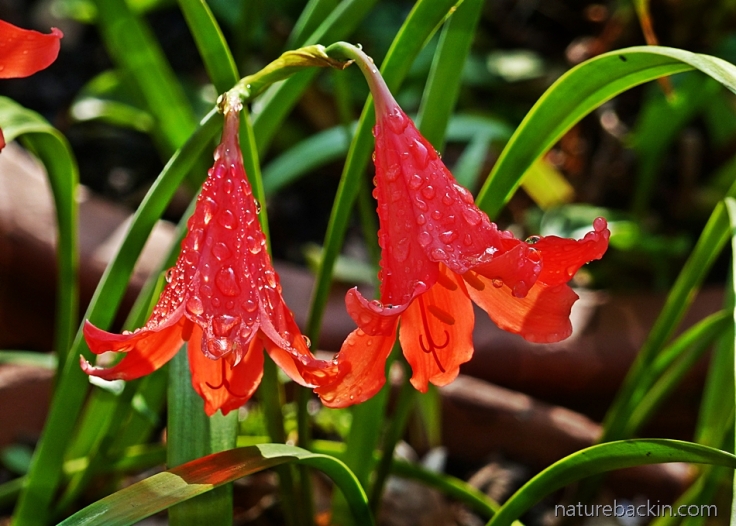
The red-hued bell flowers of the Inanda lily (Cyrtanthus sanguineus). The sanguineus part of the name means ‘blood red’
The next colour on the spectrum is orange. Where is pink, you might ask? Pink, it turns out, is an unsaturated form of red. Orange-coloured flowers are plentiful, so much so that I was spoiled for choice selecting photographs of indigenous orange flowers that grow in our garden.

Clivia miniata, a southern African endemic plant, are incredibly popular both in South Africa and abroad. In the wild they are woodland plants and this one glows in a shaft of sunlight in a patch of ‘woodland’ in our garden

The tubular flowers of the Kniphofia praecox are orange but become yellow as they open. They are visited by both insect and bird pollinators

Although orange, the flowers of this potted Begonia sutherlandii are discreet. This is one of my (many) favourite plants. I have seen it growing wild amongst mossy rocks and crevices alongside mountain streams in patches of woodland in the Drakensburg mountains

A solitary bee gathering pollen on a yellow star flower (Hypoxis hemerocallidea). Traditionally used as a medicine plant for a variety of ailments, it has risen to prominence under the misnomer African potato in recent years as a plant reputed to have almost miraculous healing properties. However, caution is advised if using raw components of this plant as they can be toxic (see http://pza.sanbi.org/hypoxis-hemerocallidea)

The dainty yellow flowers of the clinging aneilema (Aneilema aequinoctiale). Many people may regard this plant as a weed, but we were delighted by the presence of this plant that turned up uninvited in the garden. It can act as a ground cover and it scrambles through low plants in the understorey. Its leaves are slightly ‘sticky’ to touch, which is why, I assume, clinging is part of its name

An unusual yellow Kniphofia in bloom. I think it might be a hybrid. It thrived for a number of years in our garden, dying back to be dormant in the winter. Sadly, one spring it failed to regenerate
I was pleasantly surprised to find that I do have photographs of green flowers in our garden, and so there was no need to include photos of the spear-shaped flowerheads of aloes and kniphofias that remain green for a long time before the flowers open.

The pineapple lily (Eucomis autumnalis) sending forth its flower spear that is topped with a crown of bracts, causing it to resemble a pineapple

A close-up of the pale green flowers of the pineapple lily. This lily is pollinated by wasps

The tiny whitish flowers of the leopard lily (Ledebouria petiolate) turn pale green as they open. The small flowers growing on the short stalks of this low-growing lily-like plant are very popular with insect pollinators, especially honeybees

The green and white flowers of one of the Albucas are surprisingly striking. There are 60 species of Albuca in southern Africa and I am not sure which one this is
The blue, indigo, violet part of the spectrum is not without controversy. In some modern colour spectrums the colour that Newton called indigo is simply excluded. In others, seven spectral colours are retained, but Newton’s blue is renamed cyan (a pale blue), his indigo is renamed blue, and violet remains as he named it.
The human eye is not all that sensitive to colours in the blue/indigo part of the spectrum and it can be difficult to differentiate between what Newton called blue and indigo. When I was looking through my photographs of flowers to illustrate the spectrum, I thought more in terms of pale blue, dark blue (indigo) and violet, leaving out the more saturated violet that I would call purple.
So what follows are three pale blue flowers, three darker blue flowers – the colour I had the most difficulty finding – and three violet-coloured flowers.
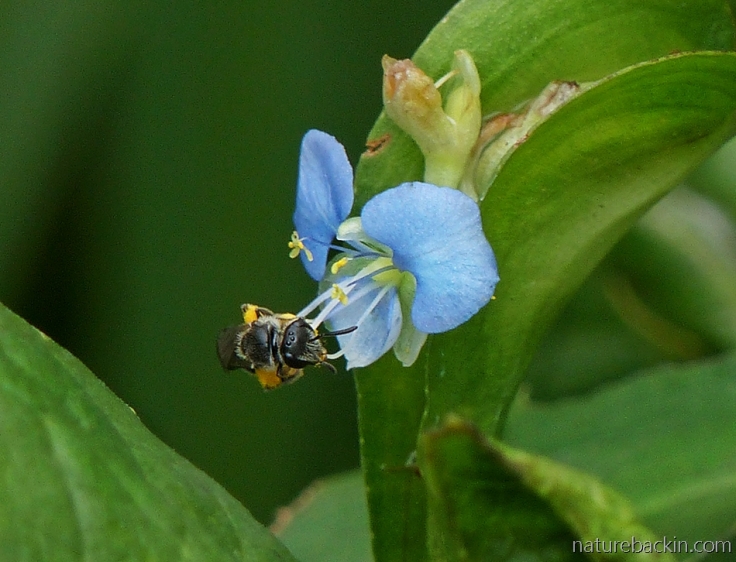
The first of the (pale) blue flowers: a Commelina. I think that this is a blue commelina (Commelina dregeanum), which has attracted a solitary bee that is collecting pollen

Rather than showcase the well-known plumbago or agapanthus, beautiful though they are, I chose the unassuming Natal blue bell (Thunbergia natalensis), a small shrubby plant that grows wild in grassland and forest margins. They readily self-seed in the garden and seem to prefer damp and shady places

Although I have showcased this plant before, I could not resist including the lovely Blue Squill (Merwillia plumbea, formerly Scilla natalensis), as the third pale blue flower
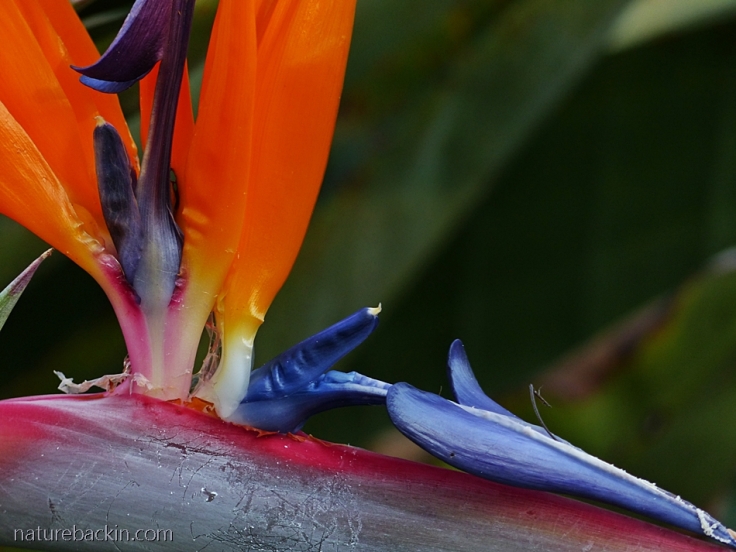
For the first plant featuring indigo (dark blue) I chose the Strelizia reginae (bird of paradise or crane flower). The orange sepals are more noticeable than the deep blue petals

I grew up knowing this flowering shrub as the Oxford and Cambridge on account of its flowers having both pale and dark blue lobes (reflecting the different blues of the jerseys worn by members of the competing rowing teams of the two universities). I discover that it is also known as Blue cat’s whiskers. Its botanical name is Rotheca myricoides (formerly Clerodendrum myricoides). Because of the bi-coloured blues of this flower, of course it can equally be featured as a representative of (pale) blue or of the darker blue (indigo)

Perhaps the various hues of blue of the flowers of this giant salvia (Brillantaisia subulugurica) are not truly dark enough to be considered dark blue (or indigo), but they aren’t exactly uniformly pale either. Indigenous to Zimbabwe and tropical Africa, this is the only plant featured in this post that is not truly southern African. There is something about this photo that reminds me of an old botanical print
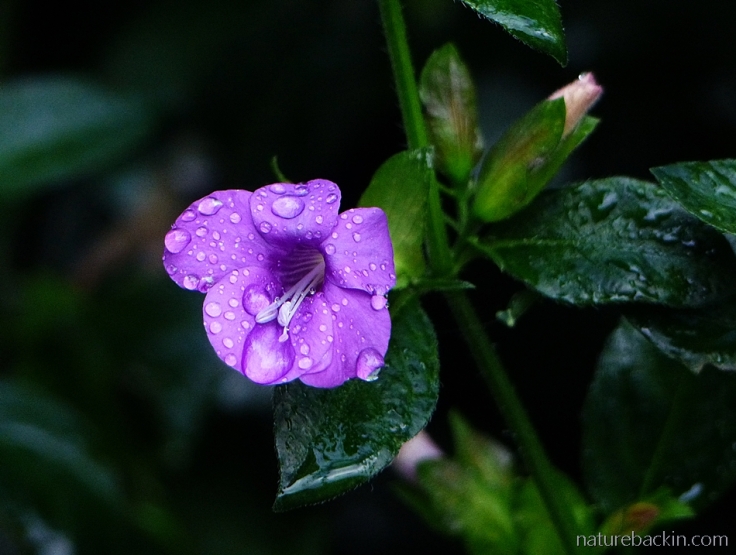
The first of the violet-coloured flowers is this Bush Violet (Barleria obtusa, or possibly Barleria repens) decorated with raindrops

The second of the violet-coloured flowers belong to the purple broom (Polygala virgate). Common to many flowers in the blue/violet part of the spectrum the colour can be really variable depending on the light, but in this photo the colour is suitably violet
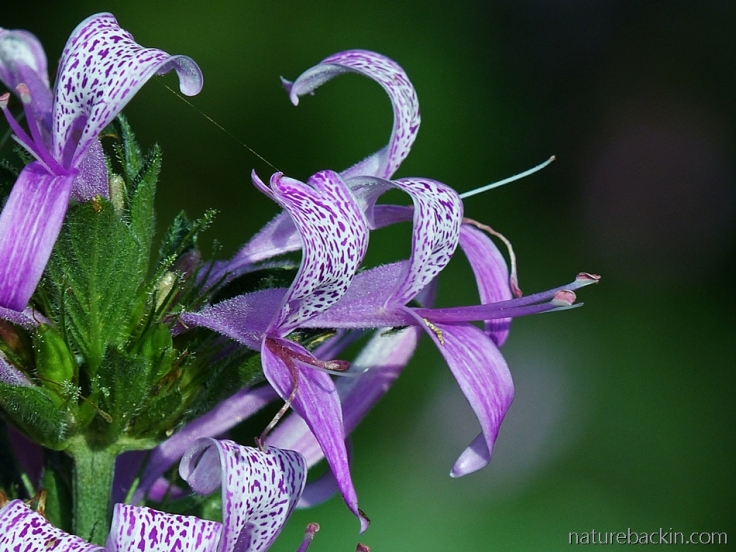
And I tie this post up with a ribbon, in the form of the ribbon bush (Hypoestes aristata). The flowers of this plant attract many insects, including butterflies (see here) and tangle-veined flies (see here)
Sources:
Helmenstine, Anne Marie. 2019. The Visible Spectrum: Wavelengths and Colors. ThoughtCo. https://www.thoughtco.com/understand-the-visible-spectrum-608329; Rodríguez-Gironés , Miguel A. & Santamaría,Luis. 2004. Why Are So Many Bird Flowers Red? PLOS. https://journals.plos.org/plosbiology/article?id=10.1371/journal.pbio.0020350; Wikipedia. 2020. Rainbow. https://en.wikipedia.org/wiki/Rainbow
Posted by Carol









February 12, 2020 at 9:51 pm
I enjoyed your flower rainbow. I was especially fond of the green and white Albucas and the violet ribbon flower that ties things up nicely. I do enjoy watching bees, butterflies, and hummingbirds select or find their colors in the rainbow of potted perennials on my balcony garden.
LikeLiked by 1 person
February 13, 2020 at 7:37 pm
Yes I like the Albucas too – something rather stylish about them. How lovely to have pollinators including even humming birds visiting the potted perennials. We don’t get hummingbirds here (only sunbirds) and it is hard to imagine from photos what it really is like to see the exquisite colours and acrobatic hovering of such very tiny creatures.
LikeLike
February 11, 2020 at 6:52 am
A simply glorious celebration of rainbow coloured flowers! xxxx
LikeLiked by 1 person
February 13, 2020 at 7:31 pm
Thanks – they really are something to celebrate!
LikeLiked by 1 person
February 11, 2020 at 2:55 am
Beautiful flowers. Kniphofia is all over CA and I didn’t know it turns from red to yellow…thought there were different colors. 😄
LikeLiked by 1 person
February 13, 2020 at 7:27 pm
Well you are right – they are different colours. In my recent post the yellow one is always yellow. For the other one the flowers do change from orange to yellow as they open, and that may be the case for some other species of Kniphofia, but changing colour like that is not representative of all Kniphofias as far as I know 🙂
LikeLiked by 1 person
February 13, 2020 at 8:41 pm
Thanks, Carol. 🙂
LikeLiked by 1 person
February 6, 2020 at 5:11 am
They’re all simply beautiful! Blooming flowers to cheer up our overcast days here. Thank you.
LikeLiked by 1 person
February 6, 2020 at 6:16 pm
Thanks Gunta – I am happy to have added some colour to your grey days.
LikeLiked by 1 person
February 3, 2020 at 6:38 am
Absolutely breathtakingly beautiful! Thank you for such an interesting, well written and put together post. Your garden must be an absolute delight! Recognized many of my favorites – stunning photography!
LikeLiked by 1 person
February 5, 2020 at 6:19 pm
Thanks very much Carol – glad many of your favourites are there too 🙂
LikeLike
February 2, 2020 at 3:38 pm
Beautiful! And fascinating. A real celebration of colour. Thanks Carol!
LikeLiked by 1 person
February 5, 2020 at 6:18 pm
Thanks Sandy. The harmonious link between the seven named colours and the seven musical notes in the scale is rather charming 🙂
LikeLiked by 1 person
February 1, 2020 at 12:46 pm
This is really amazing. Nature never ceases to fill us with a sense of awe 🙂 Thank you for sharing!
LikeLiked by 1 person
February 5, 2020 at 6:15 pm
Thanks Takami. I enjoyed selecting and sharing these images.
LikeLiked by 1 person
February 1, 2020 at 4:33 am
What a great idea for a post and nicely executed. That ribbon bush is gorgeous.
LikeLiked by 1 person
February 5, 2020 at 5:14 pm
Thanks very much Graham. The ribbon bush can look quite tatty quite soon as it flowers in succession, but fortunately the insects seem to keep on visiting regardless.
LikeLiked by 1 person
January 31, 2020 at 7:56 pm
Beautiful post , excellent photo! I don’t know how you get the colours right…some red and some blue are almost impossible to capture as they look in real life. And such a wonderful idea – love everything about it. Grateful you added all of their names too – there is so much to learn!
LikeLiked by 1 person
February 5, 2020 at 5:12 pm
Thank you so much Leya. I really appreciate your comment. Doing this post made me look at flower colours in a fresh way. I wonder if you also find it easier to photograph flowers on an overcast day or at least when the light is not too harsh?
LikeLike
February 5, 2020 at 6:05 pm
Oh, I do find overcast days the best – even misty days. And late afternoons. ♥
LikeLiked by 1 person
February 5, 2020 at 6:20 pm
🙂
LikeLike
January 31, 2020 at 10:12 am
Your posts have come to be the highlight of my week. Thank you for another exhilarating and educational peek into the natural world. Barleria is one of my favourite plants. I love the delicate flowers and admire the shrub for its hardiness. Thank you for reminding me about the ribbon bush and my intention to also plant it in our mostly indigenous garden. I read your account of the colour wheel with great interest and commend you for the research you have done.
An observation : I have noticed that in winter in the Eastern Cape there is a predominance of orange flowering plants
LikeLiked by 1 person
February 5, 2020 at 5:07 pm
Thanks for the kind comment Mariss. Glad to hear you also like Barleria and the contrast between the soft, plush flowers and the tough foliage is interesting. I hope you find a ribbon bush. It is a magnet for all sorts of interesting insects.
Here too orange flowers are predominant in winter. Perhaps that is an efficient colour for attracting pollinators? It definitely provides good cheer for us humans in an otherwise drab landscape.
LikeLiked by 1 person
January 31, 2020 at 6:27 am
Trust you to find such an original take on the flowers around you! A lovely post, and just how did you photograph the blues so well? They are such a nightmare to get right I find.
LikeLiked by 1 person
February 5, 2020 at 5:03 pm
Thanks Margaret 🙂 Yes the blues are tricky as they can look more purple than they really are. I tend to underexpose when I take photos of flowers and I wonder if that helps a bit?
LikeLiked by 1 person
February 5, 2020 at 9:18 pm
Worth a try ..
LikeLiked by 1 person
January 31, 2020 at 4:51 am
It is balm to my soul to see so many familiar KZN flowers depicted here. That you have such an array of flowers in your garden at all is wonderful to know. Here the plumbago is surviving the drought and the cross-berries are blooming. Pompon trees are bearing minute buds (wrong season) and so there is hope! Beautiful photographs and such an interesting presentation.
LikeLiked by 1 person
February 5, 2020 at 5:01 pm
Thanks Anne, and I hope your pompom trees go on to flower properly. Ours went over about three weeks ago. Plumbago is amazing. I have seen it in western KZN and into the Eastern Cape flowering in the company of the Cape honeysuckle even in dry conditions.
LikeLike
February 6, 2020 at 4:22 am
Yes, we have the plumbago and Cape honeysuckle flowering together even in very dry conditions – fortunately!
LikeLiked by 1 person
January 31, 2020 at 4:26 am
What a rainbow of beauty you have presented for our enjoyment, Carol.
Thank you!
LikeLiked by 1 person
February 5, 2020 at 4:58 pm
Thanks Sandy. I enjoyed picking out the flowers to represent each colour.
LikeLiked by 1 person
January 31, 2020 at 3:04 am
Just wow! These pics are amazing! Frame worthy, I think!
LikeLiked by 1 person
February 5, 2020 at 4:58 pm
Thanks very much for the lovely comment 🙂
LikeLike
January 31, 2020 at 2:40 am
Your garden sure is a symphony of colour, Carol!
And even though my colour-blindness, or is it colour-confusedness?, may limit the number of colours I can differentiate each and every image you shared here is amazingly beautiful.
I’ve also now learned that I’d make a good honey-bee, ‘çause I also struggle very much to notice red flowers against green foliage (often to the great amusement of whoever tries to point them out to me!)
LikeLiked by 1 person
February 5, 2020 at 4:57 pm
I am trying to imagine picking out red flowers from green leaves when the colour is not there and it is all down to texture and density. Interesting that when scuba diving as one descends the first colour to be ‘lost’ (greyed out) is red. Because of its wave-length I assume.
LikeLiked by 1 person
January 31, 2020 at 12:27 am
I’m delighted to see a full rainbow of flowers native to your region, Carol. Your photos show great detail and individual beauty. The visiting insects are icing on the cake!
LikeLiked by 1 person
February 5, 2020 at 4:52 pm
Thank you Eliza. It is nice to see insects visiting and pollinating the flowers.
LikeLiked by 1 person
January 30, 2020 at 10:17 pm
Terrific series of pics! Love the yellow Kniphofia with the water drops on it!
LikeLiked by 1 person
February 5, 2020 at 4:51 pm
Thanks very much. Those raindrops were most decorative.
LikeLiked by 1 person